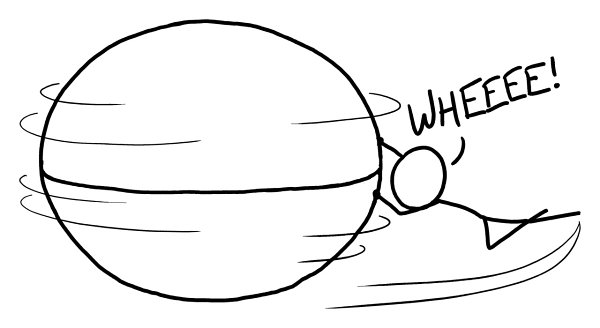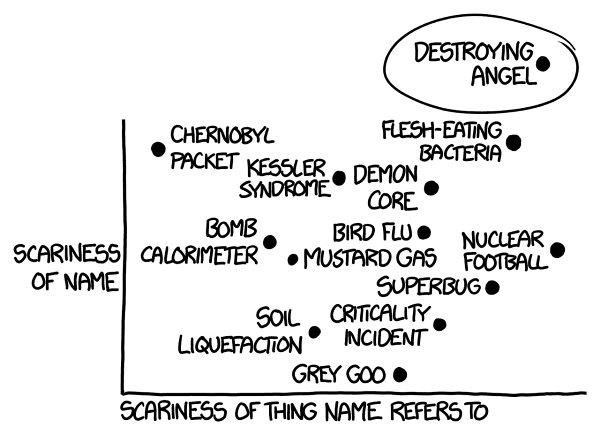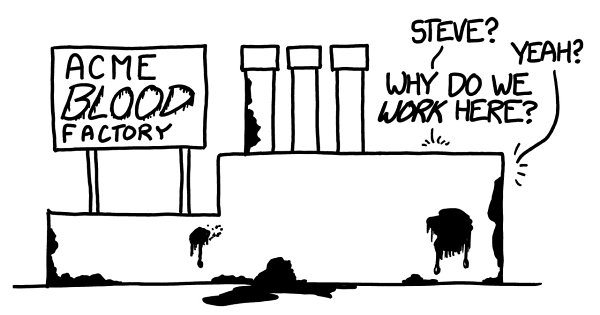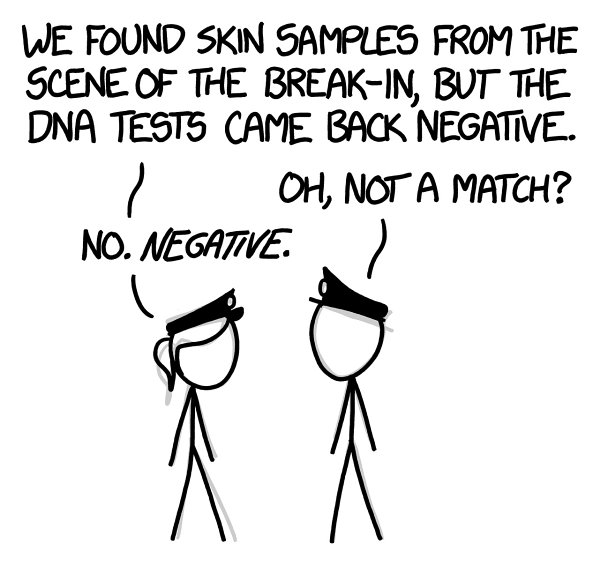What If? (22 page)
Authors: Randall Munroe

No More DNA
Q.
This may be a bit gruesome, but . . . if someone’s DNA suddenly vanished, how long would that person last?
—Nina Charest
A.
If you lost your
DNA
, you would instantly be about a third of a pound lighter.
Losing a third of a pound
I don’t recommend this strategy.
Th
ere are easier ways to lose a third of a pound, including:
- Taking off your shirt
- Peeing
- Cutting your hair (if you have very long hair)
- Donating blood, but putting a kink in the IV once they drain 150 mL and refusing to let them take any more
- Holding a 3-foot-diameter balloon full of helium
- Removing your fingers
You’ll also lose a third of a pound if you take a trip from the polar regions to the tropics.
Th
is happens for two reasons: One, the Earth is
shaped like this:

If you stand on the North Pole, you’re 20 kilometers closer to the center of the Earth than if you stand on the equator, and you feel a stronger pull from gravity.
Furthermore, if you’re on the equator, you’re being flung outward by centrifugal force.
1

Th
e result of these two phenomena is that if you move between polar regions and equatorial ones, you might lose or gain up to about half a percent of your body weight.
Th
e reason I’m focusing on weight is that if your
DNA
disappeared, the physical loss of the matter wouldn’t be the first thing you might notice. It’s possible you’d feel something
—
a tiny, uniform shockwave as
every cell contracted slightly
—
but maybe not.
If you were standing up when you lost your DNA, you might twitch slightly. When you stand, your muscles are constantly working to keep you upright.
Th
e force being exerted by those muscle fibers wouldn’t change, but the mass they’re pulling on
—
your limbs
—
would. Since
F = ma,
various body parts would accelerate slightly.
After that, you would
probably feel pretty normal.
For a while.
Destroying angel
Nobody has ever lost all their DNA,
2
so we can’t say for sure what the precise sequence of medical consequences would be. But to get an idea of what it might be like, let’s turn to mushroom poisonings.
Amanita bisporigera
is a species of mushroom found in eastern North America. Along with related species in America and
Europe, it’s known by the common name
destroying
angel.

Destroying angel is a small, white, inoccuous-looking mushroom. If you’re like me, you were told never to eat mushrooms you found in the woods.
Amanita
is the reason why.
3
If you eat a destroying angel, for the rest of the day you’ll feel fine. Later that night, or the next morning, you’ll start exhibiting cholera-like symptoms
—
vomiting, abdominal pain, and severe diarrhea.
Th
en you start to feel better.
At the point where you start to feel better, the damage is probably irreversible.
Amanita
mushrooms contain
amatoxin,
which binds to an enzyme that is used to read information from DNA. It hobbles the enzyme, effectively interrupting the process by which cells follow DNA’s instructions.
Amatoxin
causes irreversible damage to whatever cells it collects in.
Since most of your body is made of cells,
4
this is bad. Death is generally caused by liver or kidney failure, since those are the first sensitive organs in which the toxin accumulates. Sometimes intensive care and a liver transplant can be enough to save a patient, but a sizable percentage of those who eat
Amanita
mushrooms die.
Th
e frightening thing about
Amanita
poisoning is the “walking
ghost” phase
—
the period where you seem to be fine (or getting better), but your cells are accumulating irreversible and lethal damage.
Th
is pattern is typical of DNA damage, and we’d likely see something like it in someone who lost their DNA.
Th
e picture is even more vividly illustrated by two other examples of DNA damage: chemotherapy and radiation.
Radiation and chemotherapy
Chemotherapy drugs are blunt instruments. Some are more precisely targeted than others, but many simply interrupt cell division in general.
Th
e reason that this selectively kills cancer cells, instead of harming the patient and the cancer equally, is that cancer cells are dividing all the time, whereas most normal cells divide only occasionally.
Some human cells
do
divide constantly.
Th
e most
rapidly dividing cells are found in the bone marrow, the factory that produces blood.

Bone marrow is also central to the human immune system. Without it, we lose the ability to produce white blood cells, and our immune system collapses. Chemotherapy causes damage to the immune system, which makes cancer patients vulnerable to stray infections.
5
Th
ere are other types of rapidly dividing cells in the body. Our hair follicles and stomach lining also divide constantly,
which is why chemotherapy can cause hair loss and nausea.
Doxorubicin, one of the most common and potent chemotherapy drugs, works by linking random segments of DNA to one another to tangle them.
Th
is is like dripping superglue on a ball of yarn; it binds the DNA into a useless tangle.
6
Th
e initial side effects of doxorubicin, in the few days after treatment, are nausea, vomiting, and diarrhea
—
which makes sense, since the drug kills cells in the digestive tract.
A loss of DNA would cause similar cell death, and probably similar symptoms.
Radiation
Large doses of gamma radiation also harm you by damaging your DNA; radiation poisoning is probably the kind of real-life injury that most resembles Nina’s scenario.
Th
e cells most sensitive to radiation are, as with chemotherapy,
those in your bone marrow, followed by those in your digestive tract.
7
Radiation poisoning, like destroying angel mushroom toxicity, has a latent period
—
a “walking ghost” phase.
Th
is is the period where the body is still working, but no new proteins can be synthesized and the immune system is collapsing.
In cases of severe radiation poisoning, the immune system collapse is the primary
cause of death. Without a supply of white blood cells, the body can’t fight off infections, and ordinary bacteria can get into the body and run wild.
The end result
Losing your DNA would most likely result in abdominal pain, nausea, dizziness, rapid immune system collapse, and death within days or hours from either rapid systemic infection or systemwide organ failure.

On the other hand, there would be at least one silver lining. If we ever end up in a dystopian future where Orwellian governments collect our genetic information and use it to track and control us . . .

. . . you’d be invisible.
- 1
Yes, “centrifugal.” I will fight you.
- 2
I don’t have a citation for this, but I feel like we would have heard about it.
- 3
Th
ere are several members of the
Amanita
genus called “destroying angel,” and
—
along with another
Amanita
called “death cap”
—
they are responsible for
the vast majority of fatal mushroom poisonings.
- 4
Citation: I got one of your friends to sneak into your room with a microscope while you were sleeping and check.
- 5
Immune boosters like pegfilgrastim (Neulasta) make frequent doses of chemotherapy safer.
Th
ey stimulate white blood cell production by, in effect, tricking the body into thinking
that it has a massive
E. coli
infection that it needs to fight off.
- 6
Although it’s a little different; if you drip superglue on cotton thread, it will catch fire.
- 7
Extremely high radiation doses kill people quickly, but not because of DNA damage. Instead, they physically dissolve the blood-brain barrier, resulting in rapid death from
cerebral hemorrhage (brain bleeding).
